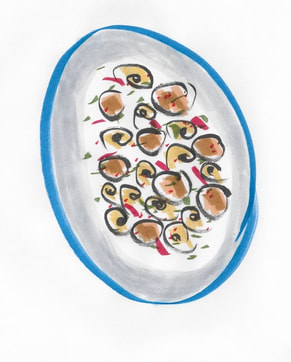 Don’t be surprised by the presence of almond on the nose. Don’t be surprised by the presence of almond on the nose. On the morning my mother passed away in my arms, I drove from Vista in San Diego County to Los Angeles. The two hours of driving north gave me time to reflect on how lucky I had been to hold my mother during her last twenty-four hours, massaging her head and arms as she took her personal journey. Instead of driving straight home, I made two stops: Santa Monica Seafood, where I purchased some plump scallops, and The Wine House, where I procured a bottle of white wine from Sardinia. This night, August 6, 2019, I would make a fine meal of pasta with scallops and sun-dried tomatoes accompanied by a white wine worthy of celebrating my mother’s life: a 2018 Vermentino by Antonella Corda. When you spot a glass of Vermentino on a wine list or reach for a bottle at your local shop, the producer is most often located on the island of Sardinia, an ancient land mass that is one of over four-hundred-and-fifty islands under the Italian flag. Sardinia, second in size only to Sicily, is known by locals as Sardegna, and you will often see this place name on the wine label. Sardinia is responsible for the production of about half of all Vermentino worldwide. Vermentino Di Gallura is Sardinia’s only DOCG (Italy’s highest designation of quality), and it is located in the northeast area of the island. Gallura is prized for its breathtaking beauty, granite soils, and famous Emerald Coast. While Sardinia was once regarded as Italy’s wild west, today it is the darling of nearly ten million tourists who visit annually. If you are an ambitious swimmer with a penchant for chasing Vermentino, you can make your way seven miles north from Sardinia to French Corsica. There, Vermentino goes by the name of Vermentinu in accordance with local naming traditions. In fact, this grape goes by several names, depending on where you are drinking at the moment. On Italy’s mainland, Vermentino is prominent in Liguria, home of the ritzy Italian Riviera. Here, the wine known as Pigato, a name that means “spotted,” because the grapes have freckles on their skin. In northwest Italy’s Piedmont region, the grape is called Favorita. A quick flight over to Southern France’s Provence and Languedoc-Roussillon wine regions will further acquaint you with this popular variety, which they call Rolle. The French there use Rolle in their production of rosé to lighten the color and to provide intriguing aromas and mouthfeel. Come to think of it, I hope that this thin-skinned grape won’t be offended as I notice that it runs with a monied, sun-seeking Mediterranean crowd. Vermentino shines at its best when planted close to the sea and you know that real estate isn’t cheap. You can also find Vermentino produced in California’s Paso Robles, Sierra Foothills, and Lodi regions, where it is appreciated for its resistance to drought and disease. There has always been confusion as to the origin of the grape, but DNA testing has most people convinced that Vermentino is native to Italy. When a server approaches you on a hot summer day with a glass of Vermentino, the aromas from the pale gold nectar will reach your nose before the wineglass, wet with condensation, hits the table. Vermentino discharges a heady mix of that may include grapefruit, lemon peel, lime, pineapple, green apple, white peach, pear, and white flowers. These fragrances are couched in savory accents of sage or scrub-brush, depending upon the vineyard location and the hand of the winemaker. Don’t be surprised by the presence of almond on the nose: this is a defining aroma of the wine. Vermentino is known for having an almost salty minerality redolent of the vineyards located along the western Mediterranean. The grapevines located on beachfront properties are natural recipients of the saltwater elements that shower their soils, grape skins and leaves. Gusty winds along the coast cool the grapes and dry them out, helping them retain their medium- to medium-high acidity. A medium alcohol level of eleven point five to thirteen point five ABV contributes to Vermentino’s refreshing quality. Vermentino is the Gemini of wine grapes, presenting you with two vastly different style possibilities. Light-bodied, easy-drinking Vermentino wines are an inviting alternative to a Sauvignon Blanc or a bone-dry Muscadet. Producers of this light style seldom use oak, instead favoring stainless steel and other neutral vessels to preserve this variety’s mix of aromas. The moment you meet the rich, opulent and sometimes creamy expression of Vermentino, you will know why I chose this style for a night of importance and reflection. This weightier style might greet you with bruised pear, sage, wet earth, brioche and almonds with a nice hit of acidity keeping everything on balance. A 2018 bottle of Vermentino Di Gallura by Piero Mancini that I am enjoying at the moment hits all of these notes, along with a generous, oily texture in the mouth. This round mouthfeel often indicates time on lees (resting time in the vessel with the yeast that fermented the wine). Creamy or dairy aromas and flavors might be introduced by the winemaker, who employs the malolactic fermentation technique to convert tart malic acid into creamy lactic acid. This bottle by Mancini, a one-hundred percent Vermentino, has a satisfying aromatic intensity and is typical of Vermentino’s medium level of alcohol at twelve point five ABV. In Tuscany’s Bolgheri village (home of Super Tuscans), Vermentino sees some of its very richest expressions, where producers rely on the interplay of skin contact, time on lees, and barrel aging to create wines of weight and extraordinary complexity. If you enjoy a rich Viognier or a Napa Valley Chardonnay, this form of Vermentino may just hit the spot. While some Vermentino wines can be aged, most should be enjoyed within three to seven years following the vintage. The Vermentino tasting experience holds yet another twist: a slightly bitter finish that reminds you of the sensation you get in the mouth from a grapefruit pith or a young almond. This counterpoint to the citrus and flower notes refreshes your palate in preparation for the next sip. Think about this sensation like you would the tannins in a red wine — a balancing component to fruity and juicy elements. What causes this unusual aftereffect? The Vermentino grape has a high level of phenolic compounds that produce a sophisticated, bitter finale. (Phenolic compounds naturally occur in plants and are valued for their antioxidant properties which are thought to reduce the risk of disease.) Considering that Italy is fond of including bitter elements in its cuisine, such as radicchio, it is fitting that this wine is not shy about rewarding us with a light kiss of bitterness.  On this night, I would make a fine meal of pasta with scallops and sun-dried tomatoes. On this night, I would make a fine meal of pasta with scallops and sun-dried tomatoes. Which foods pair well with Vermentino? My first thought for pairing food with a particular wine is to take a look at where the wine comes from and match it with foods from the same area. Ergo, why not cook up some Mediterranean food to go with your Vermentino? Your first course could be a tip of the hat to Vermentino’s citrusy character featuring an arugula salad bathed in olive oil, lemon and parmesan cheese. The arugula’s herbaceous and somewhat bitter elements are also a nifty match to the wine’s characteristics. Celebrate Vermentino’s oily mouthfeel by grilling up some sea bass, red snapper, octopus, squid, or sardines. And you don’t have to stop there while at the grill. Vermentino is a great dancing partner for grilled chicken or even lean red meats such as pork and lamb. Play on Vermentino’s savory notes by roasting artichokes, onions, peppers, sweet potatoes or eggplant. If you are in the mood for pasta, bathe it in pesto sauce to boost Vermentino’s herbal aspects. The next time you visit a local bistro for lunch, order up a spinach quiche to go with your Vermentino. The rich, creamy mouthfeel of the quiche, along with the bitter green flavors of the spinach make this meal an ideal fit for your wine. Don’t hesitate to pair Vermentino with chicken or fish tacos on a Taco Tuesday. Vermentino is a wine with personality plus, and a lot of nuance, so have fun matching and contrasting the aromas and flavors that she has to offer. I look for Mediterranean offerings along the lines of bitter salads, nuts, citrus, fish, stone fruit, oils, and cheeses with a creamy mouthfeel like Mozzarella. For additional food and wine pairing ideas, see my new book, Your Love Affair with Wine, available on Amazon. I saved the best news for last: your awareness of Vermentino as a white-wine option is good for the pocketbook. Many wine drinkers are unaware of the existence of this grape, so you may find yourself paying less than you might for a Sauvignon Blanc (light style) or a Chardonnay (rich style) of similar quality. While we’re thinking about it, let’s look at wines with similar profiles to Vermentino. When you run into these wines at the bottle shop, consider whether Vermentino is a better value. If you are shopping for fresh, light-bodied whites, you might be looking at a Sauvignon Blanc with its green apple, citrus and white peach aromas like Vermentino. How do the two wines differ? For one thing, the Sauv Blanc is likely to have higher acidity. Perhaps you could tell these wines apart in a blind tasting on that one feature alone. Or, you could be looking to pick up a bottle of Muscadet. This wine, produced in France’s Loire Valley, is dry and saline with citrus characteristics like a Vermentino. However, Muscadet wines are generally dryer and more acidic. If I was blind tasting between the two, I would identify the wine that is bone dry (Muscadet) and sniff like a bloodhound for almonds (Vermentino). Like Vermentino, Muscadet thrives near the water, but it lives in a cool climate whereas the Vermentino longs to bask like a sunbather in a warm or hot climate. Let’s say you want to pick up a Manzanilla Sherry. Like a Vermentino, you would anticipate almond aromas, salinity and a slightly bitter aftertaste. Yes, both wines share these refreshing attributes, but with Manzanilla’s ABV of fifteen to seventeen percent, you would immediately know the difference. Manzanilla has low acidity whereas a Vermentino has medium to medium-high acidity. If you are shopping for a rich, opulent white, you might be looking at a warm-climate Chardonnay, such as one from Napa Valley. This wine can offer Vermentino’s round mouthfeel and creaminess, along with nuttiness and tropical fruit notes. Chardonnay can be made in a variety of styles, like Vermentino, and may also undergo malolactic fermentation. However, an oaky, warm-climate Chardonnay is predisposed to having a lower acidity level than Vermentino. A Viognier might be on your shopping list, with its almond, citrus and peach aromas as well as an oily mouthfeel. How would you possibly tell it apart from a Vermentino? Viognier is usually lower in acidity and higher in alcohol. Or, you might be reaching for a golden Semillon wine from South Australia, with its tropical, nutty qualities balanced by a chalky minerality and an oily mouthfeel. The way to identify which is which in a blind tasting: Semillon customarily has a higher alcohol level. Our memory of a wine is brought into focus when we pair it with life events, connection with family and friends, and meaningful experiences. For me, the Vermentino grape will be inextricably tied to my mother and her loving and nurturing role in my life. When I drink Vermentino, I will think of her. When I think about my mother, I will remember the pasta dinner, the Vermentino and the conversation with my husband. Peter and I had a quiet dinner at home that night of August sixth. We discussed everything that had happened with my mother over the past several days and hours. At eighty-six, my mother had lived a generous time on earth, but it was still difficult to say goodbye. The next day, I called my daughter, Nicolette, and asked her to make the same meal and to pair it with Vermentino should she find herself in the position of celebrating my life. Ever the chef, Nicolette reminded me that scallops may not be in season at the end of my days. We struck a deal, however: a glass of Vermentino from Sardinia would be raised in my honor, as I had done for my mother. The seafood: Chef’s choice. Vermentino: General Characteristics Flavors: citrus, green apple, pineapple, white flowers, almond Acidity: medium to medium-high Phenolics: attractive bitterness on the finish Texture: fresh and light to lush and oily Alcohol: medium Body: light to full Key regions: Italy: Sardinia, Liguria, Tuscany, Piedmont; France: Corsica, Provence and Languedoc-Roussillon; US: Paso Robles, Sierra Foothills, Lodi. Parents: Unknown Origin: Likely Italy Also known as: Rolle, Favorita, Favorita Bianca, Favorita d’Alba, Pigato, Vermentini, Vermentinu, and Malvoisie de Corse.
0 Comments
|
AuthorLyne Noella Archives
October 2022
Categories
All
|


 RSS Feed
RSS Feed
